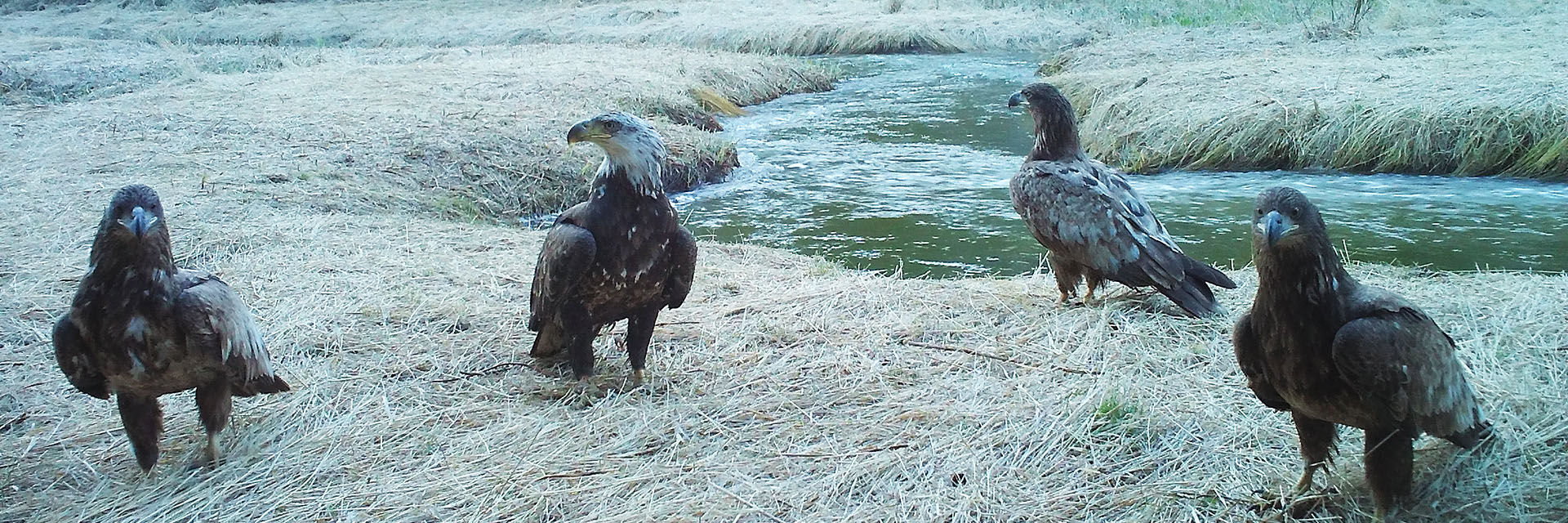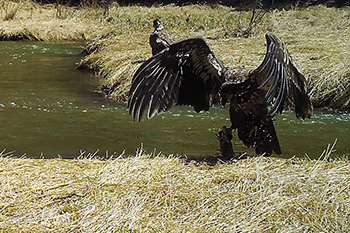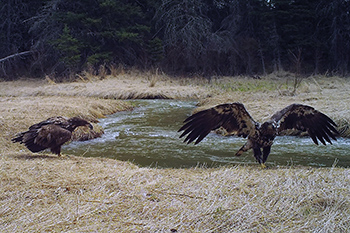
Bald eagle (Haliaeetus leucocephalus)
Riding Mountain National Park
Many Indigenous cultures believe the eagle is sacred because it flies closest to the Creator. It symbolizes respect, honour, strength, courage and wisdom. Riding Mountain National Park is home to many exciting animals, one of the most majestic being the bald eagle (Haliaeetus leucocephalus).
The name, bald eagle, refers to the white plumage on the head of the adult eagles. When eagles are born, their feathers are grey, but eventually begin to turn brown when they are ready to leave their nests. After about four years, the feathers on the head of the eagles finally begin turning white.
These beautiful photos were caught using a trail camera. Ecologists here at Riding Mountain National Park use trail cameras to learn about animal behaviours and activity without disturbing them. The use of trail cameras has allowed us to grasp a better understanding of how many birds and which species and maturities are present in the park. They also provide us with the ability to determine which areas may need to be protected from the public for certain periods of time. For example, if there is a nesting pair present, we may need to close off an area from the public in order to ensure the safety of the young chicks.
Human recreational activities, such as boating, can indirectly impact bald eagle behaviours and have long-term ecological effects. It is important that we manage recreational activities around eagle habitats therefore, we suggest that boaters stay 200-300m away from an eagle’s nest, but if the eagle flushes (meaning it flies out suddenly), turn back to avoid any further disturbance. We all must do our part to ensure the safety and longevity of these exquisite animals.
Nesting

Eagles are territorial. They make their nests near large bodies of water high up in Aspen or Poplar trees, in areas with an abundance of fish. The eagles continue to return to the same nest repeatedly over many years. Bald eagle nests tend to be quite large in order to provide for the size of the eagles.
Although the eagles in these photos are not likely nesting in this area, Riding Mountain does have its fair share of eagle nests. At Riding Mountain National Park we protect eagles by limiting disturbance near nests. For example, we may close or re-route a trail to help promote successful nesting.
Migration
Bald Eagles are migratory, travelling northward in spring to their breeding territory (RMNP for example) and returning south as water bodies freeze and it becomes difficult to find food. Migration takes a tremendous amount of energy. Therefore, when the migrating birds find a good, reliable food source, they will stop and stay for a while to refuel themselves for the rest of their journey. Visitors may sometimes see eagles in the area late in the year if they have found a patch of open water and are still able to hunt.
Diet

An eagle’s diet consists mainly of fish that they catch on their own, but they are also known to scavenge and steal fish and carrion from other animals.
Mating

Bald eagles can begin mating at the age of four. They are monogamous animals and mate for life. However, if their partner dies, an eagle will typically find a new mate. During the courtship, the mating pair will occasionally perform a sky-dance in the air together, including swoops, chases, and cartwheels, and/or magnificent mating calls. Bald eagles are early breeders and can begin the process (starting with nest building, completed by the couple together) as early as February. After egg laying and incubation, the eggs will begin to hatch from mid-April to early May. The bald eagle will lay, on average, 1-3 eggs and the young eagles will remain in the nest for 10-14 weeks before fledging, taking their first flight. Beforehand, both the male and female eagle share the responsibility of feeding the eaglets.
Species
There are over 50 different species of eagles throughout the world, but bald eagles are the only species that nest in this area. However, one can also sometimes see golden eagles (Aquila chrysaetos) pass through the area while they are migrating.
The bald eagle, with a wingspan of over two metres, making it the largest bird in this area, is a magnificent animal. We are extremely privileged to be home to such marvelous creatures. For this reason, among many others, if you see an eagle or even just a nest, we encourage you to admire them from afar. COSEWIC (the Committee on the Status of Endangered Wildlife in Canada) has classified bald eagles and golden eagles as not at risk, but these species do have a high mortality rate. Close to 50% of eagles do not survive the first year. Eagle populations have recovered significantly from low numbers in the 60’s and 70’s when their reproduction rate was reduced as a result of the widespread use of the pesticide DDT.
Related links
- Date modified :